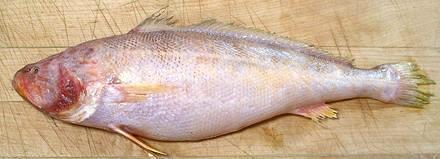 [Nebris microps alt Plagioscion microps]
[Nebris microps alt Plagioscion microps]
This fish is native to the West Atlantic, mostly off the north coast of South America from Columbia to Brazil, but a few can be found farther south off Brazil. It can grow to almost 16 inches and 1-1/4 pounds, but the photo specimen was 13 inches long and weighed 1 pound 1 oz. It is well though of as a food fish, and one of the highest priced fish in Trinidad. This fish is currently caught wild as a commercial catch and is not farmed. IUCN Red List status Not Evaluated.
More on Croakers and Drums.
This is a very good eating fish. The flesh is white with an excellent light but sophisticated flavor. Poached, it almost resembles lobster. Do not use a thick batter with this fish, just a powdering or rice flour or the like, and use a delicate sauce. You don't want to mask the flavor of the fish.
Cooking: This fish can be cooked by just about any method normal for fish. Skin shrink is so low it probably wouldn't even need slashes through the skin for baking or steaming, whole or pan dressed. The flesh holds together well enough to use in soup if it is added near the end of cooking.
Buying: Though this fish is still not at all common in the Asian fish markets here in Los Angeles, the photo specimen was purchased from one at 2014 US $2.99 / pound.
Scales: This fish is covered with medium size scales that scrape off rather easily, with only moderate flying around.
Cleaning: No particular problems here, but notice that the body cavity goes quite a bit farther back than the vent. The gills are a bit hard to pull - you'll want to use your long nose pliers.
Fillet: This fish is fairly easy to fillet, except there's nothing to guide you between the ends of the fin rays and just before the backbone. Be careful you come down on the right side of the bones. When you get to the ribcage, well, there isn't any. The skirt on this fish is thick and meaty with no bones in it. There are a bunch of spines right between the main fillet and the skirt you'll need to feel out and pull. Some of them break rather easily.
Yield: A 1 pound 1 ounce fish yielded 9-1/2 ounces of skin-on fillets (56%). That's an excellent yield as this is a very meaty fish. Skin off it was 7.95 ounces (47%), but there is very little reason to remove the skin from this fish.
Skin: The has no strong or off flavor, and almost no shrink at all. You can even poach a skin-on fillet and it will barely bend, and then the skin will soften and the bend will disappear. If you want, you can remove the skin with the usual long knife and cutting board Method, but take care, it is not really strong.
Stock: Head fins and bones make a very fine mildly flavored stock. All it needs is a little salt to make it quite palatable. Skins can be included with little change in flavor. It will have almost no oil, but you should still remove what oil there is using your gravy separator. For details see our recipe Making Fish Stock.
sf_croaksez 141010 - www.clovegarden.com